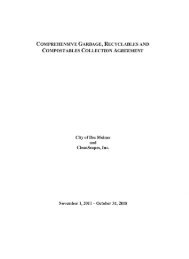CITY OF DES MOINES SHORELINE MASTER PROGRAM
CITY OF DES MOINES SHORELINE MASTER PROGRAM
CITY OF DES MOINES SHORELINE MASTER PROGRAM
Create successful ePaper yourself
Turn your PDF publications into a flip-book with our unique Google optimized e-Paper software.
Des Moines Shoreline Inventory and Characterization<br />
Mapped critical fish and wildlife habitats are shown on Figure 14. Critical fish and wildlife<br />
habitats in the City’s shoreline jurisdiction are characterized throughout the following sections<br />
describing the nearshore biological characterization.<br />
Marine Riparian Zones<br />
Marine riparian vegetation is defined as vegetation overhanging the intertidal zone (KCDNR,<br />
2001). Marine riparian zones function by protecting water quality; providing wildlife habitat;<br />
regulating microclimate; providing shade, nutrient and sources of food; stabilizing banks; and<br />
providing large woody debris (Anchor Environmental and People for Puget Sound, 2002).<br />
Marine riparian zones were examined through limited field reconnaissance and review of 2001<br />
oblique aerial photos (Ecology, 2001). The existing marina, residential and commercial<br />
development, and shoreline armoring have impacted the marine riparian zones of all the city<br />
shoreline segments. Marine riparian zones within the City’s shoreline jurisdiction are typically<br />
associated with the high, steep bluff areas of segments C, D, and E where development is less<br />
desirable. The longest contiguous stretch of intact marine riparian vegetation is found in<br />
Segment C, between S. 240th Street and Saltwater State Park (Segment D). Marine riparian<br />
zones are absent from all of segments A, B, F, and G due to shoreline armoring including<br />
concrete and wooden bulkheads, rip-rap seawalls, marinas, and boat ramps (WDNR, 2001)<br />
(Table A-3, Appendix A).<br />
Banks and Bluffs<br />
Banks and bluffs are part of the marine riparian zone and are generally the primary source of<br />
sediment to adjacent beaches (Downing, 1983), provide habitat to bluff-dwelling animals,<br />
rooting area for riparian vegetation, and a source of groundwater seepage to marine waters<br />
(KCDNR, 2001). Shoreline development and armoring, vegetation clearing, over-water<br />
structures, dredging, and changes in hydrology, among others, adversely impact the natural<br />
functions of bluffs.<br />
The ShoreZone Inventory (WDNR, 2001) maps high, steep bluffs capped by till in Segments C<br />
and D and moderate height, inclined bluffs capped by till in Segment E (Table A-4, Appendix<br />
A).<br />
Beaches and Backshore<br />
Beaches are generally steeper than tidal flats and are often comprised of boulder, cobble, sand<br />
and silt areas that form a great majority of Puget Sound’s shoreline (KCDNR, 2001). Backshore<br />
areas are immediately landward of beaches and are zones inundated by storm-driven tides.<br />
Beaches provide habitat for numerous organisms, including cutthroat trout, piscivorous birds<br />
(grebes, herons, and mergansers), and shorebirds (Dethier, 1990 in KCDNR, 2001). A typical<br />
profile of an undisturbed shoreline in Central Puget Sound would include an upper backshore or<br />
storm berm area that collects logs, algae, and other debris during storms (KCDNR, 2001). The<br />
intertidal portion of the beach is typically relatively steep and composed of a mixture of cobbles<br />
and gravel in a sand matrix (KCDNR, 2001). Sediment abundance throughout the shoreline<br />
segments is characterized as a mixture of “moderate” to “abundant” (Table A-1, Appendix A).<br />
Sediment stability within the shoreline segments is identified as both accretional and stable<br />
March 2005 Page 31



